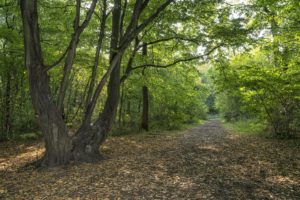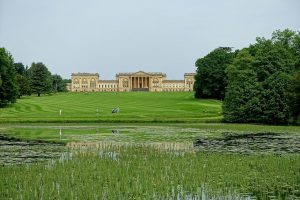Howe Park Wood courtesy of The Parks Trust
The Parks Trust calls for help in protecting one of their ancient woodlands.
The Parks Trust, the charity that cares for over 6,000 acres of parkland and greenspaces in Milton Keynes is asking for your help in protecting one of their three ancient woodlands found across the city.
Howe Park Wood, located on the west of the city, is a particularly important site, so important in fact that it has ‘SSSI status’. This means that the woodland is a ‘Site of Special Scientific Interest’ as designated by Natural England. Places that are given this status are required by law to be protected and managed in order to preserve wildlife in the area. SSSI sites currently cover approximately 7% of land in the UK, so this title is a true honour and a big responsibility for the Trust.
 Howe Park Wood provides a safe home to many endangered animal and plant species including bats, the extremely rare black hairstreak butterfly and great crested newts. All of these face UK-wide population threats and declines. The wood is also home to veteran (very old) trees including an ancient crab apple and oaks dating back 400 years. Two hundred plant species can be found here, a few of which are very rare in Britain, including Herb-Paris and some orchid species.
Howe Park Wood provides a safe home to many endangered animal and plant species including bats, the extremely rare black hairstreak butterfly and great crested newts. All of these face UK-wide population threats and declines. The wood is also home to veteran (very old) trees including an ancient crab apple and oaks dating back 400 years. Two hundred plant species can be found here, a few of which are very rare in Britain, including Herb-Paris and some orchid species.
Historically the wood was managed as a source of timber in medieval times, to rear wild pigs and as a deer park. In fact, the woodland itself was noted in the Domesday Survey of 1086, meaning this area of Milton Keynes has likely existed for well over 1,000 years. Today the wood is enjoyed by thousands of people every year, encouraging a broad love and respect of wildlife. However, with ever increasing footfall, The Parks Trust is having to take extra measures to ensure that this critical habitat is protected from permanent damage.
From March 2022, The Parks Trust are asking the public to keep all dogs on leads throughout the entire year, when walking in the woods. This is in order to protect any ground-nesting animals from being injured or disturbed by dogs. The scent left by dogs can also have a negative effect on the behaviour of other animals, so it is important that they stay on the main designated paths and do not enter the woodland undergrowth.
The Parks Trust are also asking visitors to the wood to keep to the designated pathways and refrain from entering the woodland. Regular visitors may have recently noticed some undesignated tracks that have been created by visitors through scrubland have been blocked. These have been created by years of visitors trampling plants and creating their own routes through the woods. Whilst the Trust wants to encourage exploration of nature, they do need to ensure the integrity of the woods is respected and any further damage is prevented. These blockages are therefore in place to encourage regrowth of depleted areas and further improve the woodlands biodiversity. In turn, The Parks Trust hope to see some of the rarer plant species bounce back and flourish in the woods once more.
You may also see work being carried out by The Parks Trust Landscaping team on your visit including tree thinning and coppicing work. These management practises have been carried out for centuries and have been monitored, researched and proven effective in their positive impact on improving biodiversity. In particular, they allow light to get to the woodland floor to increase woodland plants and maintain a range of habitats. One iconic and much-loved plant which benefits from this work is the English Bluebell – a threatened and protected species.
The Parks Trust would like to thank all of their park users in advance for their understanding of the changes and for helping to protect this incredibly important woodland.
To find out more about Howe Park Wood and to plan your visit, www.theparkstrust.com/howeparkwood


